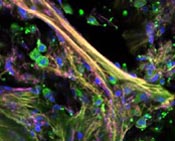A6-Subproject
Pathogen recognition by taste and odorant receptors and coupling to BALT formation and epithelial remodeling (Kummer / Diefenbach)
Specialized chemosensory epithelial cells utilize the canonical taste transduction cascade to recognize bacterial products at the mucosal surface and acutely activate mucociliary clearance through paracrine cholinergic signaling.
We will now test our major hypothesis that chemosensory cells (brush and neuroendocrine cells) orchestrate
(1) BALT (tertiary lymphoid follicles) formation and
(2) infection-induced epithelial remodeling, both via
(a) intraepithelial paracrine signaling and (b) modifying innate lymphoid cell (ILC) functions, thereby protecting from or limiting pulmonary infection, utilizing the newly identified murine pathogen B. pseudohinzii as a model organism, and the human pathogen Klebsiella pneumoniae.


 charite.de
charite.de